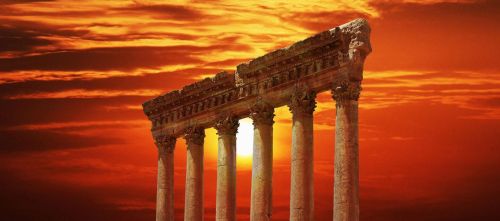Travel highlights Lebanon

Aanjar
Aanjar, 58 kilometers from Beirut, is completely different from any other archaeological experience you'll have in Lebanon. At other historical sites in the country, different epochs and civilizations are superimposed one on top of the other. Aanjar is exclusively one period, the Umayyad.
Lebanon's other sites were founded millennia ago, but Aanjar is a relative new-comer, going back to the early 8th century A.D. Unlike Tyre and Byblos, which claim continuous habitation since the day they were founded, Aanjar flourished for only a few decades.
Baalbek
Baalbeck, Lebanon's greatest Roman treasure, can be counted among the wonders of the ancient world. The largest and most noble Roman temples ever built, they are also among the best preserved.
Towering high above the Beqaa plain, their monumental proportions proclaimed the power and wealth of Imperial Rome. The gods worshipped here, the Triad of Jupiter, Venus and Mercury, were grafted onto the indigenous deities of Hadad, Atargatis and a young male god of fertility. Local influences are also seen in the planning and layout of the temples, which vary from the classic Roman design.
Beirut
A city with a venerable past, 5,000 years ago Beirut was a prosperous town on the Canaanite and Phoenician coast. Strategically located at the crossroads of three continents, Asia, Africa and Europe, Beirut is unique among world capitals. Beirut today is a hub of culture, commerce, banking and finance.
The National Museum documents the great archaeological past of Lebanon, while musical, artistic and dramatic activities take place year round. Although a new commercial center has been rebuilt, a number of traditional houses still exist. A tour of the old downtown should also include Omari Mosque, the Municipality Building, the Assaf and Amir Monzer Mosques, the arcade Maarad Street, the Parliament Building, the Roman columns on Nejmeh Square, and the historic Greek Orthodox and Greek Catholic churches opposite the Parliament. Also not to be missed is the area of Rawsheh, where Beirut's famous Pigeon Rocks stand tall and proud in the sparkling sea. The many nightclubs and restaurants of this cosmopolitan city are justly famous.
Byblos
Byblos is one of the top contenders for the "oldest continuously inhabited city" award. According to Phoenician tradition it was founded by the God El, and even the Phoenicians considered it a city of great antiquity. Although its beginnings are lost in time, modern scholars say the site of Byblos goes back at least 7,000 years. Within the old town, medieval Arab and Crusader remains are continuous reminders of the past. Nearby are the extensive excavations that make Byblos one of the most important archaeological sites in the area.
Cedars
Simply known as "The Cedars", this resort settlement in Lebanon's highest range is one of the most dramatically beautiful spots in the country. Its centerpiece is an ancient grove of cedars, a tree synonymous for millennia with Lebanon itself. Just below The Cedars is the town of Bsharre, birthplace of Gibran Khalil Gibran.
The most exciting way to get to The Cedars is from Deir al Ahmar in the Beqaa valley. The road snakes up the bare eastern slopes of Mount Lebanon presenting marvelous views at every turn. As you get higher, at the crest you look down the other side into a gigantic bowl where the ski resort, the cedar grove and the Qadisha gorge lie before you in a wide-angle panorama. Plan this route for summer or fall because snow closes the pass in winter.
Deir El Kamar
Located southeast of Beirut, Deir El Kamar is unique in Lebanon, a town restored and maintained in a style many centuries old. Shortly after Emir Fakhreddine II came to power in 1590, a chronic water shortage in Baaqline forced him to move his capital to Deir El Kamar. There he ruled until his death in 1635. The town remained the residence of the governors of Lebanon until the 18th century and is considered by many the cradle of Lebanese unity. In the beginning of the 19th century, for security reasons, Emir Bechir Chehab II moved the capital to Beiteddine. A UNESCO world heritage site, it boasts grand feudal architecture, old stepped streets, walled gardens and picturesque corners.
Sidon
The entrance to Sidon from the north is on a wide divided highway lined with palm trees. As you approach, the landmark Crusader Sea Castle and modern port installations are immediately visible. The busy main street is full of small shops of every kind, including patisseries, whose oriental delicacies are stacked in little pyramids. Sidon is famous for a variety of local sweets which you can watch being made in the old souk or in shops on the main street. The particular specialty of Sidon is known as "senioura," a delicious crumbly cookie.
Tyre
Tyre has a colorful souk (covered market) well worth exploring. Look for the Ottoman khan, or inn, just inside the market entrance. On a side street is the "Mamluke House", an Ottoman period residence that is being restored as a cultural heritage and information center by the General Directorate of Antiquities. Also in the souk area is a white, double-domed Shia mosque of great interest. Near the market you will see a busy fisherman's port, in Phoenician times referred to as the "Sidonian" port because it faced north towards Sidon. Walk along the port with the sea on your right and you enter the city's Christian Quarter, a picturesque area of narrow streets, traditional architecture, and the Seat of the Maronite bishop of Tyre and the Holy land. One medieval tower still stands in a small garden. A second one is visible under the little lighthouse. During Crusader times towers similar to these ringed the city.